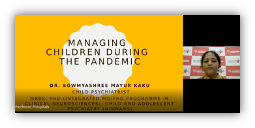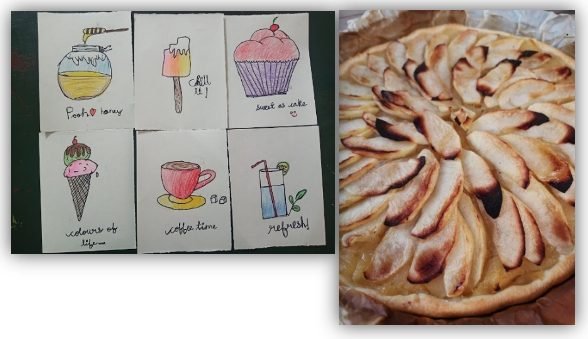Early career child and adolescent psychiatrists and COVID19 – Light at the end of the tunnel?
By Dr. Sowmyashree Mayur Kaku, MBBS, Ph.D, Bangalore, India; Dr. Ana Moscoso MD, MSc Paris, France and Dr. Jordan Sibeoni, MD, Ph.D, Paris, France
The COVID19 pandemic has impacted the lives of individuals across the globe. Early career child and adolescent psychiatrists and trainees are going through difficult times trying to balance work and family, while continuing to meet deadlines and find novel ways of pursuing clinical and research work.
Before it all started, none of us knew what to expect. The possibility of shutting down our countries was there but somehow no one could believe it could be done. Announcement of complete lockdown to limit the spread of COVID19 hindered both our daily lives and the practice of child and adolescent Psychiatry (CAP). Schools were closed and cities were empty. We were worried for our parents, our loved ones and ourselves. We were also worried for our patients as we knew we could maintain neither the continuity of care (outpatient units stopped receiving patients and families with consultations being either postponed, cancelled or conducted by telephone and video calls; day hospitals closed; only few inpatient units remained open, others were requested to become COVID units) nor our usual framework (working with masks all the time, respecting a physical distance, and so on).
Many of us feared potential problems, related to our field of work, such as
- Higher risk of child abuse and domestic violence
- Suicidal crisis, and self-injuries for adolescents having recurrent conflicts with their families and relying mostly on peer support and social life
- Exacerbation of behavioural issues for patients with developmental disorders and multiple comorbidities
- Diagnostic delay for children with neurodevelopmental disorders
- Parents exhaustion for being the only “therapists” for their children
The reality was slightly different as many hospitals reported a significant decrease in emergency visits due to fear of contamination. Face to face psychiatric care went down and work focused on
- Creating Standard Operating Procedures (SOPs) for the care of patients and meeting colleagues while avoiding viral contamination
- Disseminating advise and information about mental health and mental disease though handouts or websites (1, 2 as examples). Initially addressed to meet our patients, they finally reached a broader audience.
- Using online platforms to pursue clinical work, offering mental health support to frontline healthcare providers working in COVID units and helping out with non-child mental health duties.

Moving to virtual platforms (our kids too!)
Clinical work in child and adolescent psychiatry
Most of the clinical work with children and adolescents shifted to online platforms and teleconsultations. Emergency care was the only exception.
- At first, some clinicians were frustrated with these new formats, not familiar enough with the technology and not able either to “reach” or engage both patients and families or to “read the room”, resulting in many misunderstandings and lack of implicit speech.
Assessing younger patients (toddlers, younger children) was particularly challenging, as they would find it assumedly hard to cooperate with the video calling or phone format.

Mural painting at Robert Debré Hospital, Paris, France
- Physical and psychomotor assessments could be specially difficult. Some teams (especially the ones involved in neurodevelopmental assessments) came up with novel strategies such as asking parents to send video samples of children prior to the consultation which could include speech, play, social and communication samples in natural settings, with a wide variety of interactions with various family members, and then go through the videos before the consultation to be able to guide the families better.
With the absence of “outside stress”, many adolescents with social anxiety issues (such as school refusal, bullying or panic disorder with agoraphobia etc.) felt better and really enjoyed teleconsultation.
- Clinical work with children and adolescents shifted to many new cases of internet and gaming addiction, interpersonal issues with families and stress related to increased indoor time.
- Psychiatric assessment in ERs for acute situations was also challenging as everyone was wearing a mask, hiding facial expressions on which we rely –intuitively- a lot to interact and show empathy.
- From parents, we heard their experiences of staying home with sick kids. Parents have come up with creative strategies to take care of their children’s issues including trying newer home-based therapy techniques.
- Working from home was also a breach of privacy (clients being able to see our home – even to the slightest extent). Moreover, very often being an early career child and adolescent psychiatrist means having young kids that could sometimes cry/sing/dance/yell in the background. We had to become more confident with self-disclosure and accept to let a part of our life be seen (or heard) by our patients. Needing to finish household chores and fit in consults during the day was stressful in the beginning and we slowly learnt to rearrange things.
Research work in child and adolescent psychiatry
- Community work and field visit based research has come to a grinding halt. Redoing forms for Institute Ethics Approval and amendment of ongoing research methods to be able to move a large chunk of assessment/training/face to face work to online platforms has been challenging.
- Clinic visits of new or follow-up children and adolescents have drastically come down due to the pandemic thus reducing the numbers to be recruited for research purposes. This throws challenges to complete research on time, keeping up with deadlines and writing reports to funding agencies and managing payment of junior research staff.
- This crisis also provided new research opportunities, with original and innovative research questions or hypotheses – for example, the lived experience of children with ADHD at home, online therapies for those with autism or anxiety who have difficulties in social situations, description of at-risk population such as young students living alone in big cities, tele psychiatry; and collaboration all over the world.
Meetings, presentations and conferences –
- While some of the meetings were cancelled, most were moved to the virtual platform too.
- National meetings predominantly happened during weekends and after office hours while international meetings were late at night (for India – due to differences in time zones) as most were held by societies located in North America, Europe and UK.
- These virtual opportunities however, helped to attend more meetings without having to pay a lot for registrations/ make travel arrangements with/without family, while the downside was the over-packed day and tight weekend schedules. We also did not get to meet our friends and colleagues personally or meet potential mentors and collaborators thus making it difficult to take some of the research opportunities forward.

When we started getting the hang of going virtual! (Learning, presenting and teaching!)
And what about mental health of early career child and adolescent psychiatrists?
Psychiatrists are not immune to experience the stress induced by these unprecedented times. Some colleagues experienced “physiological” anxiety/panic. Time was uncertain – until when should I stay in this? What can be thought as temporary? How to make it real if temporary? Space was most obviously changed.
Some also experienced the feeling of being privileged, or even a fraud, that is to have all the benefits of being a healthcare professional – shops offering us 10% discount and opening in certain hours only for us, school being available only for our kids, thankful neighbours and friends – without being in the frontline or directly involved with the healthcare management of the crisis. Even if most of us were working from home, with more time (and less commute!), for many it was too difficult to focus on work and be productive.
What helped?
- Staying in touch with friends, family and colleagues
- Seeking help from our parents and others to help with the kids,
- Talking to mentors and creating a practical plan,
- Giving time for self-care (however little),
- Spending quality time with family,
- Establishing virtual networks, collaborations,
- Working on backlogs including manuscripts.

We learnt doodling and made apple pie with our kids!
Resources for early career researchers-
Though there aren’t any from low- and middle-income countries, here are some links which can be beneficial.
- https://www.sfn.org/initiatives/confronting-covid-19
- https://www.srcd.org/event/home-child-experts-science-stress-and-coping-during-covid-19
- https://www.unicef.org/india/media/3401/file/PSS-COVID19-Manual-ChildLine.pdf
If you are interested to talk about this, share your experiences, or have more resources that can help, we are happy to hear! Do write to Dr Sowmyashree Mayur Kaku – sowmeey@gmail.com
[1] https://www.pedopsydebre.org/fiches-pratiques
[2] http://www.mda.aphp.fr/

